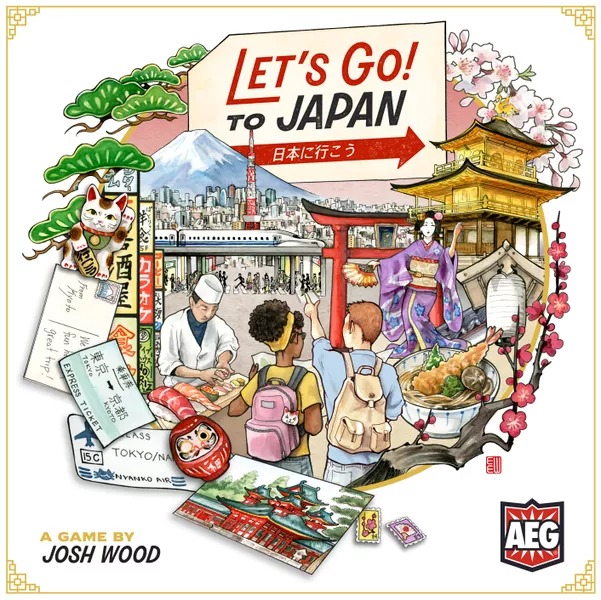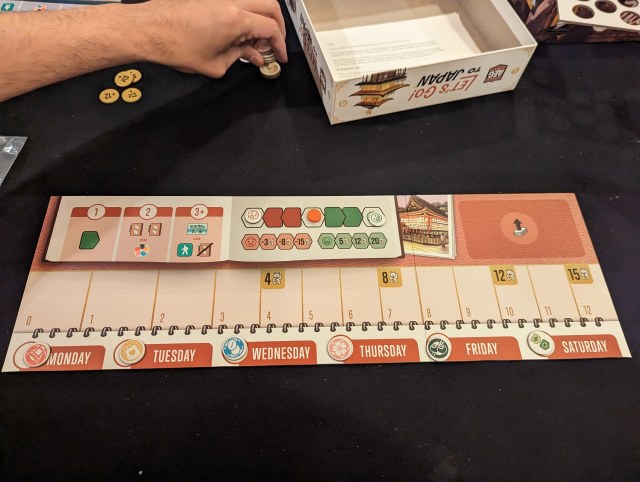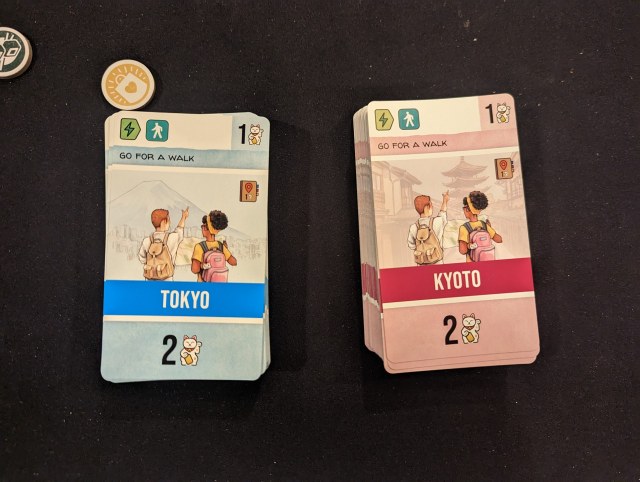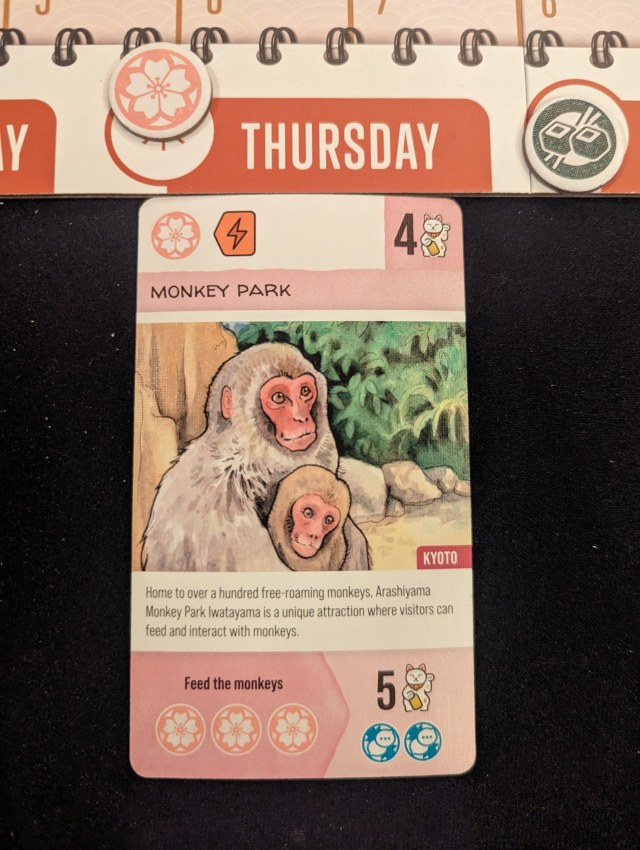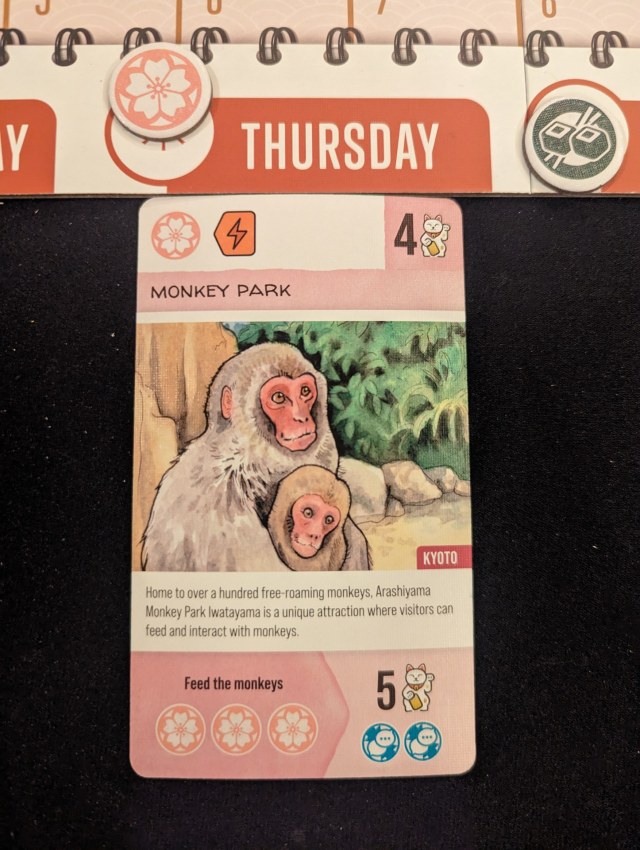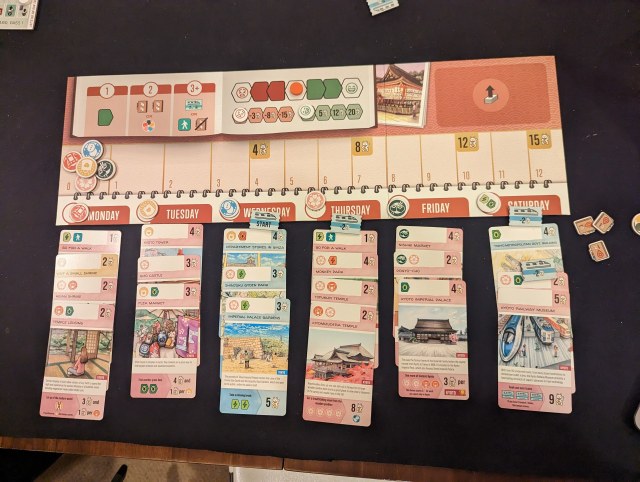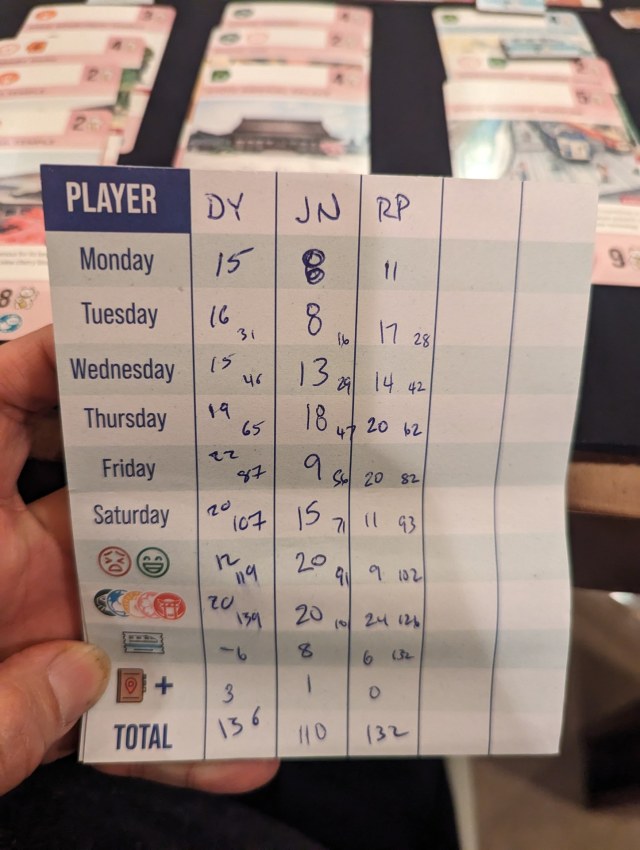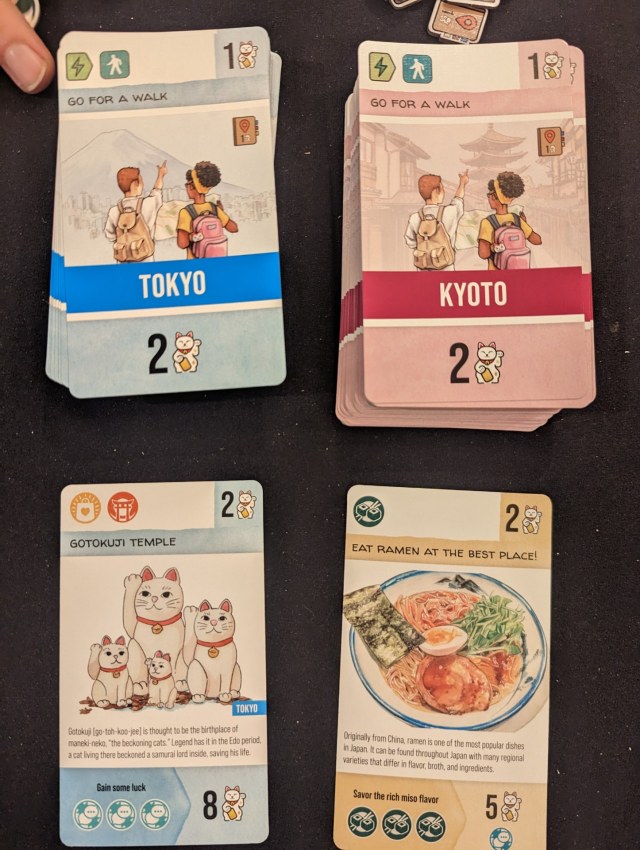Let’s Go! To Japan
- Designer: Josh Wood
- Publisher: AEG
- Players: 1-4
- Age: 10+
- Time: 45 minutes
- Played with preview copy provided by AEG
- KS link – https://www.kickstarter.com/projects/alderac/lets-go-to-japan-from-aeg
Per AEG: “In Let’s Go! To Japan, you are a traveler planning, then experiencing your own dream vacation to Japan. The game consists of thirteen rounds in which players draw activity cards illustrated by Japan-based artists and strategically place them in different days in their week-long itinerary. These can’t-miss tourist attractions will have you bouncing between Tokyo and Kyoto as you try to puzzle out the optimal activities to maximize your experience while balancing your resources. The game ends with a final round in which you ultimately go on your planned trip, activating each of your cards in order along the way. The player who collects the most points by the end of their trip wins!”
In this game, players vie to plan the best vacation to Japan; splitting time between the two major cities of Tokyo and Kyoto. The designer was apparently motivated to make this game when the COVID pandemic cancelled his real life trip to Japan!
Each player gets their own board which has slots for six days of travel. Above this is a large score track for your five attribute markers. Finally at the top, there is a player aid, a place to track your mood, and a space for other players to deposit cards. One player randomly places the 6 Favorable condition tokens on the six days of their board, and everyone else copies this pattern. The two decks of cards, one for Kyoto and one for Tokyo, are shuffled and placed on the table. The all-important turn tracker is placed in the center where all can see it.
The cards have a lot on them. At the top, there is a point value for playing the card as well as experience icons (Temples, Food, Nature, Shopping, Unique experiences). The middle has the title, some great artwork depicting the topic of the card and them a short paragraph explaining something about that location or thing. Finally, at the bottom, there are some bonus scoring criteria if this card is the Highlight of the Day. There are a few multiples in the decks, but there are a lot of different locations and activities depicted on the cards in this game.
Each round follows a pretty simple format. First you draw cards based on what the round tracker tells you to do. You may draw from the face down decks and/or from the facedown stack on your player board (which gets populated when other players discard cards to you). Then, the round board tells you how many cards you will play to your board and how many you will discard.
When you play cards, you place them underneath the six day columns on your board. Interestingly, though you play the cards throughout the course of the game, and while the cards give you icons and VPs, you do not score them until the very end. Just play them to the table and move on.
You can play a card to any day, and if previous cards are already played to that day, you can place them freely above or below those cards – just keep all your cards for a day in a single stack, such that you can easily see the icons and VPs at the top. Once you settle on a location, you can’t move it again later, so be sure in your decision.
If you don’t like the choices in your hand, you can plan on a walk – discard any card to the discard pile and then take to top card of either deck and place it face down onto a day. (All the cards say “Go For a Walk” on the back). You also get one research token when you do this. Research tokens can be discarded at any time to allow you to draw any 3 cards and then immediately discard 3 cards to the central discard pile.
You can generally have 3 cards in a column, and once you have played your third card to a day; you immediately check to see if you get a bonus. In setup, players placed a Favorable Condition token next to each day; if you have 1, 2 or 3 matching icons in your completed day, you will get an immediate bonus:
- 1 match – move the mood tracker one space to the right
- 2 matches – take 2 research tokens or one wild attribute token
- 3+ matches – take a special train token or take an extra walk; put an additional face down card into the day
After you have played the requisite card(s), you should then pass the remaining cards in your hand to your opponent – the board tells you which direction to go. Your hand is empty, and you’re ready for the next round. Follow the pattern on the round board to complete all 13 rounds. At the end, you will have played 18 cards, enough for three to each of the six days on your vacation. Your trip is fully planned, and now it’s time to actually go do the things that you’ve planned! You’ll need to put train tokens down on your itinerary. Each time you move from Tokyo to Kyoto (or vice versa), you must put a train token down. A normal train token comes with a -2VP penalty, but the special train tokens you can get from the Day bonus scoring are worth positive 2VP instead and 1 happiness.
One player takes the score pad and records scores. Players will go through their vacation, starting with Monday and going all the way thru the week to Saturday, going from top to bottom in each day. As you encounter a card, move your attribute markers ahead one space for each matching icon found on the top of the card. If you have a green (happy) arrow or a red (stressful) arrow, move your mood token in the direction of that arrow. Though you don’t score trains at this time, don’t forget to take the happiness if you have a special train token on that day! If you ever reach the extreme left of the track, move your stress score to the next space and reset your mood token. Likewise, if you reach the extreme right of the track, move your happiness score to the next space and then reset your mood token.
Whichever card is at the bottom of the stack, i.e. fully exposed, is the highlight of the day. See if you meet the criteria shown on the card, and if so, score points as indicated. The criteria are met based on the positions of your attribute marker at the time of that particular highlight scoring.
You likely will have some walk cards in your trip as well. When you come across one, you pick it up and turn it over to read what the surprise location is on the other side. You can choose to either use this new mystery location or leave the card face down as a walk. Score the side of the card you choose to leave visible, and note that if you use the back side, you get to place a walk token on the card to get credit for taking that walk.
Total up your points for the day – adding up the points on all the upper right corners of the cards as well as any points scored from the Highlight of the day bonus, assuming you met the criteria for scoring, and then write the tally down on the score sheet for that day. Repeat the process for all six days.
At the end of the trip, also add up the points from your happiness and stress charts, putting that number on the sheet as well. You can add up the points on your train tokens as well. Look at the locations of your five attribute markers on your track and score the VPs based on the scoring lines that each have passed. Finally, score 1VP for each unused research token you have left. The player with the most points wins.
My thoughts on the game
So, I didn’t realize it until I looked it up on BGG, but I’m apparently a big fan of Josh Wood’s work – in the past few years, I have very much enjoyed some of the games that he’s worked on; Santa Monica (designer), Tiny Towns (developer), and the Guild of Merchant Explorers (developer). This game was pleasing both to the mind and the eye, and it has definitely been one of my favorites of Spring 2023 so far.
If you have read the travelogues of James Nathan posted here about his most recent Tokyo trip, you’ll likely gather that he’s a vacation planner. His prepwork is amazing; hotels, restaurants, activities, ways to get there, backup ways to get there if something happens, etc. This game brought back fond memories of reading about his trip as you have a similar feel here – you plan out your trip first, and then you see how everything turns out when you score at the end.
There is a lot of strategy that goes into the planning of your trip, and a certain amount of luck to draw the cards you need. You can only play a limited number of cards each turn, and your hand is empty at the end – there is no way to save cards. If you end up with two cards that you want, you’ll have to make a difficult decision on which one to keep and which one to pass onto an opponent. While the direction of passing does change once during the game; for the most part, once you pass a card, it goes off in a direction and couldn’t possibly come back to you unless passed all the way around – and this seems unlikely.
You’ll have to consider whether or not to match the icon of the day, what card to leave at the bottom for the highlight, calculating where your attribute tokens will be at the end of each day in order to try to score said highlight, monitoring the progress of your mood token in order to try to score happiness bonuses or avoid aggravation maluses, etc. Some turns will be super easy as one card works and the other simply doesn’t – but man, be prepared for some harder choices when all the cards are good. If they’re all bad, don’t forget about the option to simply discard a card and go for a walk. Sure, it’s a compete crapshoot; but the walk itself isn’t necessarily awful, and there is always the chance that you draw something awesome.
Thus far, I have definitely tried to get a few columns that all match the icon of the day; getting the +2VP bonus trains really has paid off for me; allowing for some worry free travel between the two cities; and this in turn makes more cards look attractive when I’m choosing what to play. Other players have found that going for the research tokens has instead been better – allowing them to draw 3 cards to look at when their hand options aren’t ideal; and this has often paid off as well.
One thing that our group has chosen to do is to have player focus on their own board; I’m sure there is possibly a slight increase in success if you carefully looked at what your opponents were doing and then you could determine cards of which city you’d like to pass – but the payoff here is pretty small for the time it would take. We’ve chosen to play with a gentleman’s agreement to just focus only on your own board and then pass cards – not looking to see what your opponents might be collecting. This strategy may not work for all groups, but for us, it keeps the game firmly in the 30 minute range, and that is perfect for the weight of this game.
One thing that we all laughed at during the rules teach was this line: “It is strongly recommended for your first game… to have players take turns narrating the enriching activities they did for each day.” I thought, surely, there is no way we’re doing this. But, then we did. And really – that’s what makes the game so cool. As you read out the locations, and some of the necessary flavor text – you really do weave a story about your vacation; sometimes adding in other things you might do. It really makes you feel like you’ve taken a trip, and I must say that it makes the game better. The awesome graphics and the detailed text on each card also help you feel like you’ve really been to these places.
Let’s Go! To Japan immerses the players in trip planning for their upcoming Japanese vacation. Between the art and the flavor text, I have found that I really feel like I’m planning a trip; and I’m the sort of person who actively enjoys the planning of a trip as much as the trip itself. The gameplay is engaging with quick turns, and when combined with a theme that really appeals to me – this one will be a keeper for sure. I’m looking forward to many Japanese trip planning sessions this spring, and who knows, maybe this game will help me when I actually make it back to Japan!
Ratings from the Opinionated Gamers
- I love it! Dale Y
- I like it.
- Neutral.
- Not for me…
There is clearly some interest in the game, having funded on KS in 7 minutes… Go check it out – https://www.kickstarter.com/projects/alderac/lets-go-to-japan-from-aeg

